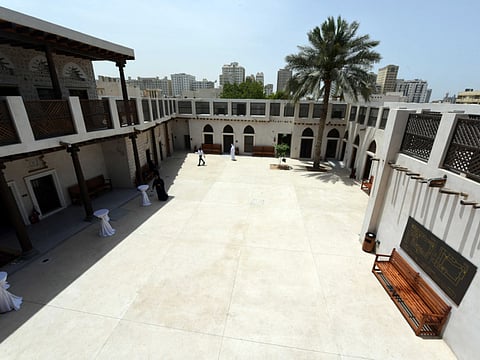Renovated grand house in Sharjah opens doors for visitors
Once owned by wealthy pearl merchant Al Naboudah is now a museum

Sharjah: The fortunes of the pearl trade and a way of life now lost have been encapsulated in Bait Al Naboudah (Home of Naboudah), the grand house of one of Sharjah’s most successful pearl merchants, which has reopened as a museum.
After restoration works, the house built in 1854 is again welcoming visitors, guided by staff of Sharjah Museums Authority.
Perhaps the first thing that strikes visitors is the scale — rooms lining a huge courtyard, and a “summer house” on the second floor.
The second thing that pulls you in is the beauty — the coming together of sandy coral walls interspersed by dark teakwood columns.
This was arguably the biggest and prettiest house (spanning 1,100 square metres) in Al Souq, old Sharjah’s central neighbourhood that is now within a preserved heritage district called the Heart of Sharjah.
A traditional bedroom complete with antique furniture. Arshad Ali/Gulf News
It was once home to Obaid Bin Eisa Bin Ali Al Shamsi, who was nicknamed Al Naboudah by traders, and his family. The rooms have been turned into “themes” showcasing belongings, house design, and traditions, which narrate a history of pearl trade and culture in historic Sharjah.
Before the discovery of oil, trade, especially in pearls, was the main driver of wealth here. Al Naboudah certainly was wealthy, trading with other merchants in the Gulf as well as exporting pearls to Europe from his base in Mumbai, India. He travelled to London, Paris and Africa to expand his markets.
In 1928, according to a ledger entry, he made 34,998 British pounds — equivalent to over £2 million today (around Dh10.2 million).
The ledger and the house are the only two things in the exhibits that can be attributed to Al Naboudah (the rest are from family, relatives, business associates and other sources). The ledger was gifted by a family member to His Highness Dr Shaikh Sultan Bin Mohammad Al Qasimi, Member of the Supreme Council and Ruler of Sharjah.
On Tuesday, tour guide Amna Al Raisi said in the summer, men from the countryside would come to the settlement of Sharjah for pearl diving and trading, taking out loans for the venture. “They would pay back the debt at the end of the season. The peal trade was central to life then and the main market was India, which Al Nabooda made his home for seven years. His house incorporates materials and elements of design influenced by India.”
Speaking earlier at the reopening of the museum, Manal Ataya, director-general of the Sharjah Museums Authority, had said: “Bait Al Naboudah has been fully restored to its former glory and is now a wonderful example of the home of a very successful pearl merchant.
“Experts from the Sharjah Institute for Heritage were careful to use a mix of traditional and modern techniques in the renovation work so that the restored building is an authentic representation of its past.”
Dr Shaikh Sultan had inaugurated the restored Bait Al Naboudah earlier this month.
Besides its size, the house, originally built by Al Naboudah’s father, gets its high stature through 24 columns made by teakwood from India. As the family grew, so did the house. Generations of Al Naboudah family lived there until the 1960s or 1970s. Al Naboodah today is a leading family business name in the UAE.
Bait Al Naboudah was first restored in the early 1990s and then from 2014 to 2016.
What makes the house “architecturally unique” among Sharjah’s other traditional buildings, notes a gallery poster, are the decorations found throughout the home. There are several floral and geometrical patterns carved or moulded on the walls.
A spiralling narrow flight of stairs leads to the second storey where a “summer” loft was used as a retreat from the day’s heat. It features “wind scoops” to catch the breeze through openings along the outer walls, which direct cooler outside air into the lower half of the huge room. Meanwhile, trapped hotter air inside escaped through decorative openings opposite the scoops, creating ventilation and cooling.
The design and decoration of the house are a testament to the lengths that Al Naboudah went to create a fusion of art and innovation.
Bait Al Naboudah
Open: 8am to 8pm (4pm to 8pm on Friday)
Entry fee: Dh10 per adult, Dh5 per child
Located: Heart of Sharjah, near Souq Al Arsah
Sign up for the Daily Briefing
Get the latest news and updates straight to your inbox



